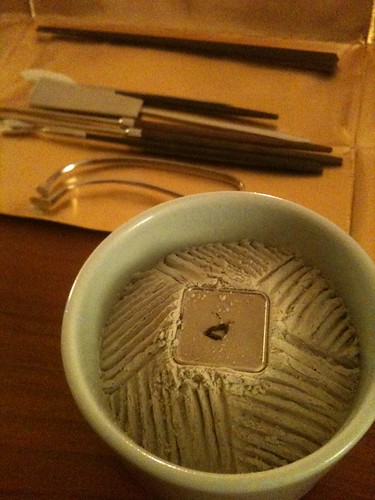Listening to Incense

And as if walking all around the botanical gardens wasn't amazing enough for one day - there were more to come as the evening unfolded. Yuko Fukami (Parfum Phyto) has invited Lisa Fong (Artemisia Perfume) and me to her home. She has just come back from Japan and wanted to share with us some of the rare woods she brought with her.
It was my first time ever experiencing incense-burning the Koh-Doh style. In this technique, the woods are not burnt, but rather warmed up on a paper-thin mica plate. The plate is placed on top of a heap of ash that is carefully decorated like raked sand in a Zen garden; and conceals a burning ember - a natural coal that was placed in there before hand.

Lisa had no idea what was awaiting us, as she's never heard of Koh-Doh (the way of incense) and so everything was completely new to her. As for me - even though I have some of the basic koh-doh tolls (the ash bowl, ash and neat square bamboo coals) - nothing in the world could have prepared us to the experience we were about to have.
Yuko spend most of her life in the USA, so there was non of the strict code of silence you'll have to obey in Japan. She explained to us every step and what she's experienced in Kyoto in a traditional incense ritual.
Once the charcoal was warm, and the pattern was formed on top of the rice ash, Yuko began opening each one of the little packets which were placed on the rainbow-shaped wooden tray. Everything in Koh-Doh is wrapped in beautiful handmade Japanese paper (including the tools you see next to the bowl).
There is a single purpose for everything in Japanese ceremonies. Yuko and I were particularly excited about the feather - a new tool in her collection, which I knew of but had no idea what it's used for. It's sold purpose is to brush the sides of the bowl in order to clear it of any excess ash, after the pattern has formed. This way the bowl looks neat and tidy.
each of the six packets were carefully labeled in Japanese calligraphy. Using tiny tongs, Yuko placed each peace of agarwood shaving (as thin as a mosquito's leg!) over top the warm mica plate. She demonstrated the cupping technique, in which the hands protect the precious smell from escaping and allows it to penetrate one's nostrils and entire being. The cup is passed in a a specific way so the pattern is always facing outwards. It might seem from the outside as if each participant is inhaling the steam of a very fine tea, and savouring it (we will get into the aroma later).
Everything is done in silence and each person in this unique commune would write their impressions later on a piece of paper, or if prompted to discuss it, the ceremony's recorder would write it on a rice paper scroll (which Yuko got to keep from the ceremony she attended in Japan). Each woods is passed several times until its aroma is too faint.
Now that I explained the process, you're probably dying to hear what the smell was like. We smelled only one type of wood: agarwood, or kyara (prounouced "Ka-Rah", with a rolling Japanese "R", of course). Each had its own specific characteristic and country of origin. However, although they were all agarwood, they did not smell the same at all. Some were sweet and flowery, while others more spicy and warm. Others were smoky and animalic. The interesting thing was that there was no real smoke involved - only gentle heating of the wood to release its rare aroma, to redeem its soul and unite with it for a few precious moments. The experience was like no other - neither incense burning, nor experiencing pure agarwood oils; and believe me, I've burnt some amazing incense in my life already, and smelled enough agarwoods to be able to tell that they can be strikingly different from one another...
It felt as if we were not burning incense, but communing with ghosts. There was a real presence and personality to each wood, and although the experience is very different from that of perfume - there seemed to be phases similar to the top/heart/base in Western perfumery, that are innate to the wood itself. As the aroma dissipated different facets revealed itself - what at first smelled minty, would have ended smelling more woody-clean.
Agarwood is such an incredibly powerful plant, that it might feel as if you're completely intoxicated when inhaling its deep aroma. It's very difficult to describe the scents, and even more difficult to recall it over a week later. At some point in our conversation, I realized that describing the different woods is defeating the purpose of Koh-Doh: savouring the aroma, diving into it and allowing it to possess you, and sharing this precious moment it with the other participants. But I could be wrong - as categorizing and describing is a huge part of classic Koh-Doh.
Only one thing was for certain: each wood had its own personality, and we were having way too much fun. The hours just went by and it wasn't till about midnight that we left, not completely sure that our state of mind was safe enough to drive.
